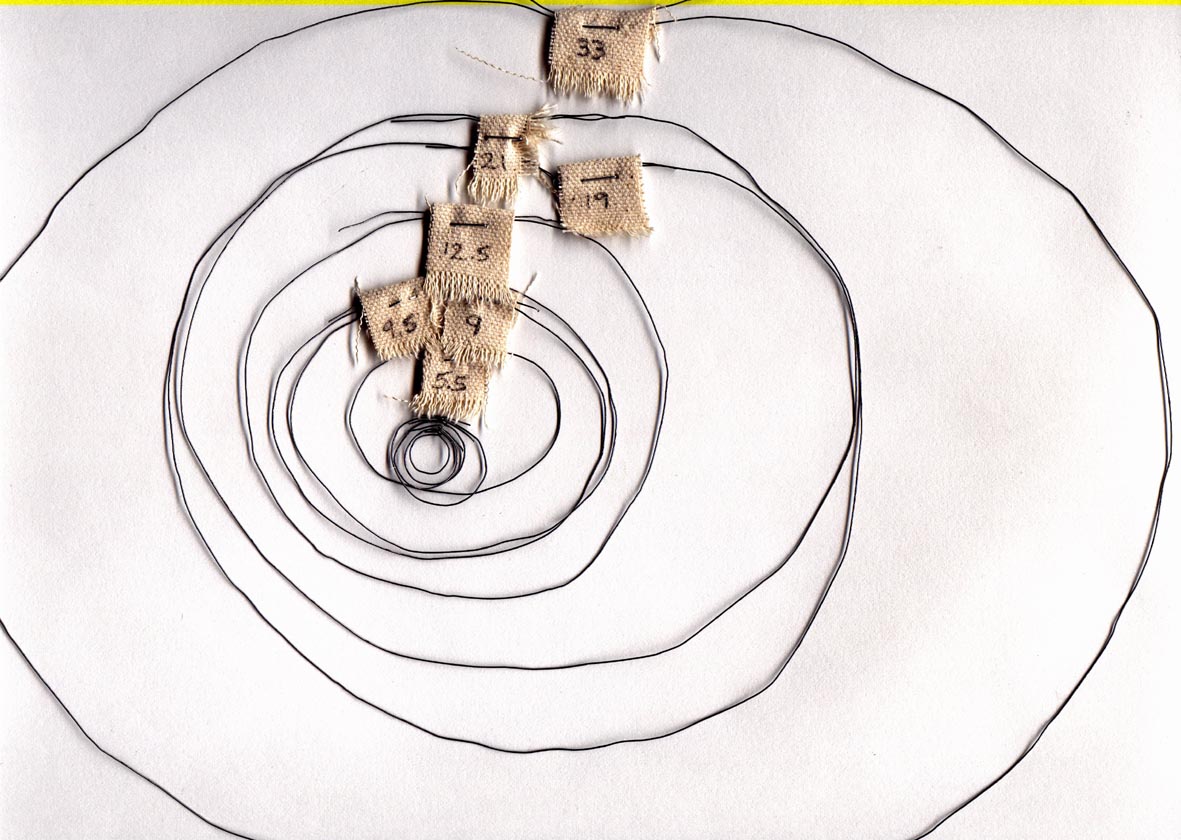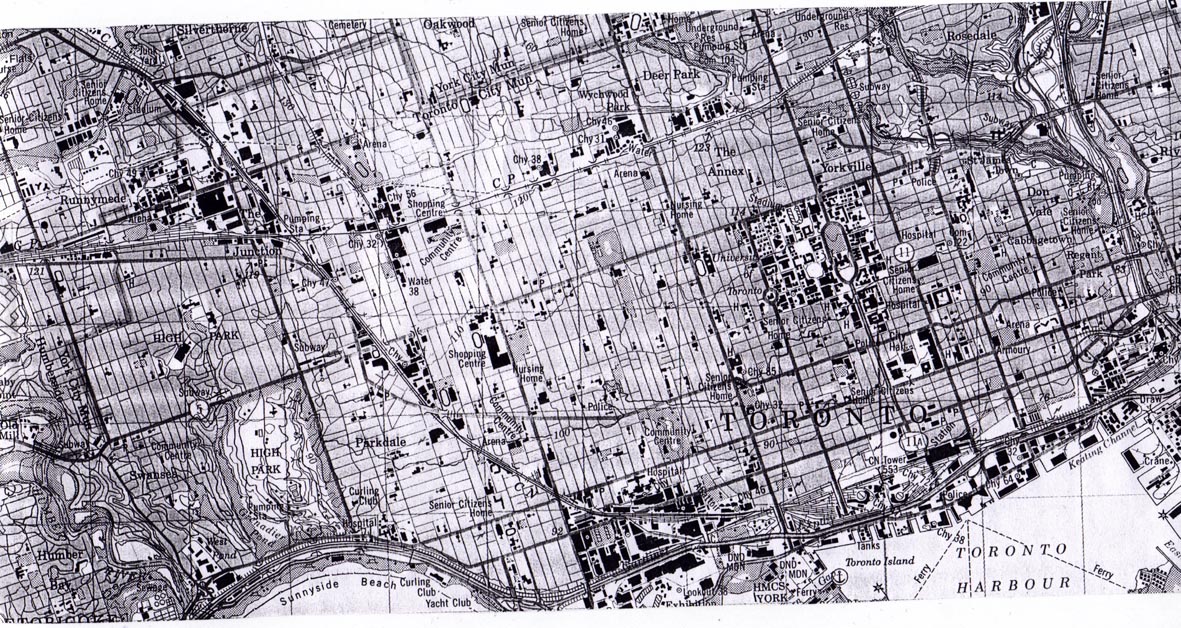Women Artist Links General Art Links Moira Fogarty's Projects Joyce Wieland
Identity: Comparing Topologies




Project 1: Identity
Comparing Topologies
"The land is the source of our collective identity -- it shapes our culture and our language.
The land is our life."
James Arvaluk, Inuit spokesperson
Artist's Statement:
This is my now completed Identity project, called Comparing Topologies. The work consists of four panels: the first is a 1:10000 scale black and white street map of an area of the City of Toronto; the second, a translucent topographical tracing of the same map; the third, a colour photo of the artist's torso; the fourth, concentric wire circles with canvas labels that represent measurements of the artist's body. The piece is intended to address several issues, including the artists relationship to her surroundings and her own body, as well as the viewer's relationship to the piece and to their own ideas of place and physicality. The statement made by alternating street map, topographical, photograph, measurements, is that there is a parallel between the relationships of these images. The visual representations of Toronto and the artist allude to what you might expect to see if you found these objects in reality, but they cannot possibly convey the experience of the real thing. Similarly, one can get a sense of the size, the rise and fall, hollows and curves of both the city and the body by examining the measurements and lines on the topographies, but there is an ultimate failure to communicate the way these movements translate to the landscapes themselves. This piece questions ideas of scale and representation, as well as the ties between the two most concrete objects which shape identity, the body which we occupy and the area we live in.
The Method Behind the Madness:
The Street Map - It took me a surprising amount of time to find this in the map room at Robarts library. I had to sift through a number of maps with different scales (1:200, 1:2000) before deciding on one that fit. My criteria included finding a map that would encompass the area of the city which I frequent in my daily routine and the parts that I know about through cycling and shopping and newscasts. I wanted it to be an intimate size, so that the whole area would roughly coordinate with the size of my body as displayed in the wire map. I also wanted street names and major landmarks to be visible, to keep it as informative as possible so as to stress the irony of its failure to communicate.
The Topographic Map - I could not find any maps that laid bare the curvature of the land in the manner that I wanted, so I had to resort to hand drawing. I like the final effect, though, in that it allowed me to choose the material I drew the map on, and I picked a translucent piece of paper, again trying to allude to the idea that even this exposure of the movement and curvature of the land was just an illusion, not a true explanation of the feel of riding your bike up the hill to Casa Loma or the long easy glide down to the Harbourfront. I felt that the process was also very educational for me, physically tracing the lines of demarcation, learning the precise elevations of the city I call my home. By exploring these building blocks of my identity, I am also enhancing my own awareness of it.
The Photo Map - This photo is as personal an expression of my physical self as possible in a two dimensional image -- the shot was set up and taken by me personally with the aid of a remote control, it was shot in my bedroom, and it shows the bulk of my body, nude, under a bright overhead light. But at the same time, the photo, like the map of the city, hides more than it reveals. To think that you know my body by looking at this portrait is foolish. Not only is my back concealed, but I have also cropped the frame to hide my legs and the top of my head, just as I cropped the street map to contain only the parts of the city that I know, rather than the entire space. One of the best things that happened by accident in this collection of images is the similarity between the negative space created by the curve of my hip and belly at the northern edge of my portrait and the curve of the waterfront that defines the southern extreme of the map of Toronto. They appear as mirror images of one another, adding to my idea of a parallel.
The Wire Map - This is the only section of the work which is not two-dimensional. The reason for this is that I wanted to ensure that the scale of the "map" was exactly one to one, and I also wanted to address some of the problems of defining identity through physical appearance. The wires are bent into the shape of my body measurements at waist, hips, neck, wrists, ankle, fingers, toes, etc. This has the double effect of showing the precise curvature of my body as well as being adjustable (I cut the wirees longer than necessary) to provide for the contingency of growth or shrinkage, the natural fluctuations in body mass and weight. The wires are also labelled with torn scraps of canvas stapled to them. These scraps are reminiscent of fabric labels, to bring up the issue of clothing as an expression of physical identity.
Ideas That Fell By the Wayside:
I had originally thought of a series of ideas to do with expressing myself through an exploration of my own personal tastes. I decided to abandon this idea because my tastes are so varied they give very little impression of a cohesive personality, and besides, they are constantly in flux, especially at this turbulent time in my life, the transition from schooling to adulthood and a career. This project seemed to embrace some larger issues which I have always struggled with, such as my body and the idea of women my age going through major crises of identity and turning to anorexia or bulimia as solutions. It also helped mt to determine a sense of place which defines me, a very pressing issue at this time in my life when I must decide where I choose to live and work. One of the main concepts underlying this work is the idea of pinpointing an elusive quality (identity) by triangulating its position through two concrete objects which relate to and define it.
Another early idea which I had, but decide not to pursue in favor of this was the idea of heritage and naming, by doing a piece which involved sculptures of myself, embraced by a larger figure of my mother, embraced by a larger figure of her mother, showing the idea of a maternal line. I thought of accompanying this with a collage on the wall behind of pictures of different women named Moira of all ages and races, from around the world, which I would glean from the internet and assemble, each with the label "Moira" beneath, to show the absurdity of this idea of taking your identity from a name, especially from a parent's name handed down to you. This would have been a deflation of something which I actually take quite seriously, as I consider my name as a link between myself and the other women in my family, as an heirloom of sorts. This would have been a questioning of that tradition, and a challenging of my own sense of uniqueness. I may end up doing this project at a later date.
If you have any questions, comments, or constructive criticism about this project, please contact me through email at moira.fogarty@utoronto.ca
Personal Influences
Doug Sensei School Heritage Parents Broccoli Olivia Garden Home Japan Music Tori
It is wonderful to feel the grandness of Canada in the raw, not because she is Canada but because she is something sublime that you were born into, some great rugged power that you are a part of...
-- Emily Carr (1871-1945), Canadian painter and writer
people have visited this site since its creation February 8th, 2000.